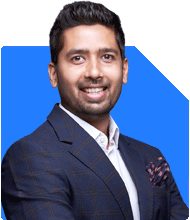How can I double my 1 crore investment?
Ramalingam Kalirajan |9126 Answers |Ask -Follow
Mutual Funds, Financial Planning Expert - Answered on Jul 16, 2024
He has an MBA in finance from the University of Madras and is a certified financial planner.
He is the director and chief financial planner at Holistic Investment, a Chennai-based firm that offers financial planning and wealth management advice.... more

How to invest 1cr and make it double?
Setting Clear Financial Goals
Before diving into specific investment options, it's essential to set clear financial goals. Ask yourself:
What is the timeframe for doubling your investment?
What is your risk tolerance?
Do you have any immediate financial needs or liabilities?
Setting clear goals helps in creating a tailored investment strategy.
Diversifying Your Portfolio
Diversification is a key principle in investing. It helps in spreading risk across different asset classes. Here are some areas to consider:
Equity Investments
Equity investments have the potential for high returns. Investing in well-managed equity mutual funds can be a prudent choice. These funds are actively managed by professionals who aim to outperform the market. The potential for higher returns comes with higher volatility, so it's important to have a long-term perspective.
Debt Investments
Debt investments provide stability to your portfolio. They include instruments like corporate bonds, government bonds, and debt mutual funds. These investments are less volatile compared to equities and offer regular income. A balanced mix of equity and debt can optimize your portfolio's risk-return profile.
Gold
Gold is a traditional safe-haven asset. It acts as a hedge against inflation and market volatility. Investing a portion of your portfolio in gold, through sovereign gold bonds or gold mutual funds, can add an extra layer of security.
International Funds
Consider diversifying globally by investing in international funds. These funds invest in markets outside India, providing exposure to global growth opportunities. They also help mitigate risks associated with domestic economic factors.
Evaluating Actively Managed Funds vs. Index Funds
You mentioned index funds, but let's evaluate why actively managed funds might be more suitable for your goal.
Disadvantages of Index Funds
Index funds track market indices and offer average market returns. They lack the potential to outperform the market. In volatile markets, index funds can experience significant fluctuations, impacting returns. The passive nature of index funds means they don't capitalize on market opportunities.
Benefits of Actively Managed Funds
Actively managed funds, on the other hand, are handled by professional fund managers. These managers actively seek investment opportunities to outperform the market. They adjust the portfolio based on market conditions, aiming for higher returns. This active management can be beneficial in achieving your goal of doubling your investment.
Regular vs. Direct Funds
Investing through a Certified Financial Planner (CFP) using regular funds can provide several advantages over direct funds.
Disadvantages of Direct Funds
Direct funds might seem cost-effective due to lower expense ratios. However, they require continuous monitoring and in-depth market knowledge. Without professional guidance, investors might miss out on lucrative opportunities or fail to rebalance their portfolios effectively.
Benefits of Regular Funds
Regular funds, through a CFP, offer expert advice and active portfolio management. A CFP provides personalized investment strategies, regular reviews, and adjustments to align with your goals. This professional guidance can enhance your chances of achieving higher returns.
Strategic Asset Allocation
Strategic asset allocation is crucial in doubling your investment. Here’s a suggested allocation:
Equity: 60%
Invest 60% of your portfolio in equity mutual funds. Focus on a mix of large-cap, mid-cap, and small-cap funds to capture growth across market segments.
Debt: 30%
Allocate 30% to debt instruments. Include a mix of corporate bonds, government bonds, and debt mutual funds to ensure stability and regular income.
Gold: 5%
Invest 5% in gold to hedge against inflation and market volatility.
International Funds: 5%
Diversify globally by investing 5% in international funds. This provides exposure to global markets and reduces domestic market risks.
Monitoring and Rebalancing
Investing is not a one-time activity. Regular monitoring and rebalancing of your portfolio are essential. Market conditions and personal circumstances change over time, necessitating adjustments.
Quarterly Reviews
Conduct quarterly reviews of your portfolio. Assess the performance of each asset class and make necessary adjustments. Rebalancing ensures your portfolio remains aligned with your risk tolerance and financial goals.
Professional Guidance
Leverage the expertise of your CFP for regular portfolio reviews. A CFP provides insights into market trends and helps in making informed decisions. Professional guidance ensures your investment strategy adapts to changing market conditions.
Tax Efficiency
Maximizing returns also involves minimizing tax liabilities. Here are some strategies for tax-efficient investing:
Equity Funds
Hold equity investments for more than one year to benefit from long-term capital gains tax, which is lower than short-term rates.
Debt Funds
Debt funds held for more than three years qualify for indexation benefits, reducing taxable gains.
Tax-saving Instruments
Invest in tax-saving instruments like ELSS (Equity Linked Savings Scheme) for additional tax benefits under Section 80C of the Income Tax Act.
Emergency Fund and Insurance
While focusing on investment growth, don't overlook financial safety nets.
Emergency Fund
Maintain an emergency fund equivalent to six months of living expenses. This fund should be easily accessible, ensuring you can handle unforeseen expenses without disrupting your investments.
Insurance
Ensure you have adequate life and health insurance. Life insurance provides financial security for your family, while health insurance covers medical emergencies. Adequate insurance prevents dipping into your investments during emergencies.
Avoiding Common Pitfalls
Here are some common pitfalls to avoid on your investment journey:
Chasing High Returns
Avoid the temptation to chase high returns through speculative investments. High returns come with high risks. Stick to a well-diversified portfolio and a disciplined investment strategy.
Market Timing
Attempting to time the market can lead to missed opportunities and losses. Focus on long-term investing and stay invested through market cycles.
Lack of Patience
Investing requires patience. Market fluctuations are normal, and short-term volatility shouldn't deter you from your long-term goals. Stay committed to your investment plan.
Benefits of Professional Guidance
Working with a CFP offers numerous advantages in your investment journey.
Personalized Strategy
A CFP designs a personalized investment strategy based on your financial goals, risk tolerance, and time horizon. This tailored approach enhances the likelihood of achieving your objectives.
Expertise and Experience
CFPs bring expertise and experience to the table. They stay updated with market trends and regulatory changes, ensuring your investments are well-informed and compliant.
Regular Reviews
CFPs provide regular portfolio reviews and adjustments. This proactive approach keeps your investments aligned with your goals and market conditions.
Final Insights
Doubling your 1 crore investment is a realistic goal with the right approach. Start by setting clear financial goals and diversifying your portfolio across equities, debt, gold, and international funds. Opt for actively managed funds to leverage professional expertise and capitalize on market opportunities.
Invest through regular funds with a Certified Financial Planner to benefit from personalized advice and active portfolio management. Conduct regular reviews and rebalancing to adapt to changing market conditions and personal circumstances.
Remember to focus on tax efficiency, maintain an emergency fund, and ensure adequate insurance coverage. Avoid common pitfalls like chasing high returns and market timing. Patience and discipline are key to successful investing.
By following these strategies and leveraging professional guidance, you can achieve your goal of doubling your investment. Stay committed to your plan, and over time, you'll see your wealth grow.
Best Regards,
K. Ramalingam, MBA, CFP,
Chief Financial Planner,
www.holisticinvestment.in
You may like to see similar questions and answers below
Kirtan A Shah | Answer |Ask -Follow
MF Expert, Financial Planner - Answered on Jul 03, 2023
Ramalingam Kalirajan |9126 Answers |Ask -Follow
Mutual Funds, Financial Planning Expert - Answered on Aug 23, 2024
Ramalingam Kalirajan |9126 Answers |Ask -Follow
Mutual Funds, Financial Planning Expert - Answered on Sep 04, 2024
Ramalingam Kalirajan |9126 Answers |Ask -Follow
Mutual Funds, Financial Planning Expert - Answered on Jan 06, 2025
Prof Suvasish Mukhopadhyay |1536 Answers |Ask -Follow
Career Counsellor - Answered on Jun 22, 2025
Prof Suvasish Mukhopadhyay |1536 Answers |Ask -Follow
Career Counsellor - Answered on Jun 22, 2025
Prof Suvasish Mukhopadhyay |1536 Answers |Ask -Follow
Career Counsellor - Answered on Jun 22, 2025
Prof Suvasish Mukhopadhyay |1536 Answers |Ask -Follow
Career Counsellor - Answered on Jun 22, 2025
Prof Suvasish Mukhopadhyay |1536 Answers |Ask -Follow
Career Counsellor - Answered on Jun 22, 2025
Prof Suvasish Mukhopadhyay |1536 Answers |Ask -Follow
Career Counsellor - Answered on Jun 22, 2025
Prof Suvasish Mukhopadhyay |1536 Answers |Ask -Follow
Career Counsellor - Answered on Jun 22, 2025
Prof Suvasish Mukhopadhyay |1536 Answers |Ask -Follow
Career Counsellor - Answered on Jun 22, 2025
Prof Suvasish Mukhopadhyay |1536 Answers |Ask -Follow
Career Counsellor - Answered on Jun 22, 2025
Prof Suvasish Mukhopadhyay |1536 Answers |Ask -Follow
Career Counsellor - Answered on Jun 22, 2025


















